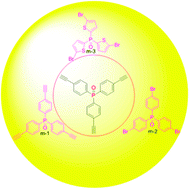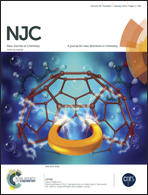Phosphine oxide-based conjugated microporous polymers with excellent CO2 capture properties†
Abstract
Three novel phosphine oxide-based conjugated microporous polymers TEPO-1, TEPO-2 and TEPO-3 are designed and synthesized, which are constructed using the phosphine-based building unit tris(4-ethynylphenyl)phosphine oxide with linkers tris(4-ethynylphenyl)phosphine oxide, triphenylphosphine oxide and tri(thiophen-2-yl)phosphine oxide via Sonogashira–Hagihara homo-coupling or cross-coupling condensation reaction. The adsorption isotherms of N2 reveal that the Brunauer–Emmett–Teller (BET) specific surface areas of TEPO-1, TEPO-2 and TEPO-3 are 485 m2 g−1, 534 m2 g−1 and 592 m2 g−1, respectively. However, these three polymers have strong affinity for CO2, which exhibit relatively high sorption abilities for CO2 (273 K/1.0 bar: 6.52 wt%, 7.62 wt%, and 8.40 wt%). Meanwhile, the TEPOs demonstrate ultrahigh hydrogen uptake and outstanding CO2/CH4 selectivity compared to analogous materials with similar BET surface areas using C, Si and N as the nodes. This work reveals clearly that the gas uptake capacity of material is highly dependent on the length of the rigid skeleton and the modification of functional groups in the monomer structure.


 Please wait while we load your content...
Please wait while we load your content...